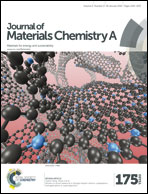Perovskite solar cells based on bottom-fused TiO2 nanocones†
Abstract
Compared to the fast electron transport in perovskite and rapid electron injection from perovskite to TiO2 nanoparticle scaffold, the slower electron transport rate in mesoporous TiO2 is reported to be a hindrance factor for power conversion efficiency. One-dimensional nanomaterials are believed to show faster carrier transport rate. In this paper, vertically aligned one-dimensional TiO2 nanocones on transparent conducting oxide were synthesized and utilized as a promising scaffold for perovskite solar cells. A simple concentration-dependent CH3NH3PbI3 seeding spin-coating method was developed to effectively improve the surface coverage at low cost. The resultant perovskite solar cells realized an average power conversion efficiency up to 11%, which is higher than that of rectangular TiO2 nanorods-based device. Besides the faster electron transport rate and slower recombination in such one-dimensional nanostructures, we attribute the superior performance of the nanocone-based device to the fact TiO2 nanocone arrays allow more CH3NH3PbI3 to deposit. By scaling up the nanocone-based devices to 1.2 cm2, they yielded a decent average power conversion efficiency of ∼6%. The combination of TiO2 nanocones with perovskite paves a way to take full advantage of one-dimensional nanomaterials and organic–inorganic perovskites for photovoltaic applications.


 Please wait while we load your content...
Please wait while we load your content...